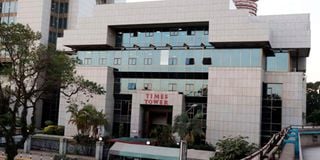Premium
KRA in plan to snoop on your WhatsApp chats

Times Tower, the KRA headquarters.
What you need to know:
- KRA said the digital lab will target forensic acquisition, extraction, and discovery of electronic evidence.
- KRA disclosed that it will enlist special software to access data from Macintosh computers, iPhones, iPads and other smartphones.
The Kenya Revenue Authority (KRA) is setting up an advanced forensic laboratory that will allow it to mine data, including hidden accounts and records, from taxpayers’ computers and mobile phones to detect tax and financial fraud.
The move by the taxman’s newly formed intelligence management division comes amid a strong shift to online transactions and electronic record-keeping by businesses as opposed to the traditional paper-based accounting systems.
KRA said the digital lab will target forensic acquisition, extraction, and discovery of electronic evidence.
“A lot of evidence gathered during the course of investigations is digital in nature such as e-mails, texts, video, audio, image files, and other transactional data on hard disks and other storage media,” the agency said in a disclosure on the new laboratory.
“The investigations of such crimes require sophisticated data acquisition, mining, analytics, and storage tools in addition to technical expertise to reconstruct the transactions and provide insights into complex crimes,” it added.
Many large corporations, including some multinationals and mobile phone operators, presently hand records of their transactions to KRA teams in soft copy.
Online transactions
The shift to online transactions has however proved problematic for tax audit and investigation teams amid growing tendencies by some firms to hide their actual financial transactions and accounts.
Additionally, an option of password protection in the digital records has proved a challenge for tax investigators and auditors seeking to get full access to all data from computers or phones seized during investigations into suspected fraud or tax evasion.
KRA disclosed that it will enlist special software to access data from Macintosh computers, iPhones, iPads and other smartphones.
“The tool should also be compatible and have ability to extract, analyse data from all types of phones and tablets, should include full range of peripherals and accessories needed for mobile forensic investigations, including connectors ... faraday bags, memory card readers, SIM and micro-SIM ID Cloning cards, camera of capturing images of the data or screenshots directly from the device...” the taxman disclosed in a tender call for supplies to the forensic lab.
In its budget for the financial year ended June 30, 2021, KRA set aside Sh31.19 million to acquire an intelligence gathering system as it steps up its war on tax evasion.
As part of the digital intelligence gathering, KRA has introduced stringent conditions requiring businesses to acquire internet-based electronic tax registers (ETRs) and connect them to its systems for real-time monitoring of their daily sales.
The two systems will give KRA a view of goods as they leave the production line to the point of exchange between retailers and consumers, collecting what is due at each point along the supply chain.
Curb tax evasion
The Value Added Tax (Electronic Tax Invoice) Regulations, 2020 require all businesses with an annual turnover of at least Sh5 million to have ETRs. Under the new system, KRA now receives sales and invoice data from all registered firms and traders daily in a fresh push to boost revenue collections and curb tax evasion.
Traders are also required to seek the taxman’s permission to perform any other business the next day through the system, meaning that incorrect or incomplete data logged the previous day could lock them out.
Failure to comply with the regulations attracts a fine not exceeding Sh1 million, imprisonment for a term not exceeding three years, or both.
The internet-enabled ETR come with several unique features. For example, it captures the personal identification number (PIN) of the gadget’s buyer. Capturing the buyer’s PIN is however optional when generating an invoice and it is only applicable where the purchaser intends to claim input tax for the VAT paid.
The new ETRs also have a control unit serial number issued by KRA to identify each tax register, beside a control unit invoice number, which is a unique number generated by the tax register upon issuance of each tax invoice.
The gadgets also come with a Quick Response (QR) code that helps one to confirm the validity of the tax invoice.
Besides the real-time monitoring of transactions through the internet, KRA also announced installation of flow meters and closed-circuit television cameras (CCTV) in alcohol manufacturing factories—guaranteeing the state round-the-clock information on the operations of manufacturers to curb tax evasion.
The taxman has further deployed IT systems on the supply side, with the rollout of the Excisable Goods Management System (EGMS) in 2013 that facilitates tracking stamps on excisable goods along the supply chain to account for payment of taxes. The digital stamps were meant to replace paper stamps but are also prone to counterfeiting.
Now, KRA has expanded its surveillance through the mass custody flow meter that will track high volumes of alcoholic beverages produced to maximise the excise tax collected.
CCTV cameras will also allow the taxman to track what the firms are producing.
The technology is expected to complement the existing EGMS.





